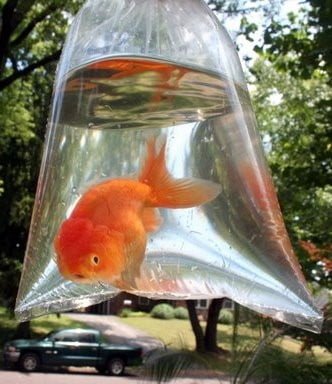New goldfish is exciting
New goldfish are often placed in quarantine to prevent infection, however, in a short time the health of the fish degrades. The goldfish keeper assumes the fish was diseased. Quarantine tanks are typically set up improperly, putting the fish at risk of oxygen deprivation. In a short time the fish will be poisoned by ammonia. When it sickens, the goldfish keeper thinks the fish was infected
Do not quarantine new fish unless you have the proper set up; a filtered, oxygenated and toxin free environment
Breeders and pet shops alike go to every length to make sure their fish are free of disease. The biggest risk to your new fish is external parasites which are relatively simple to eliminate
Choose a goldfish that is behaving normally and doesn’t show any signs of sickness. The tail fin should be in good shape, not torn or frayed. The dorsal fin should be erect, not clamped to the body. The fish should not be at the surface gasping, nor should it be lying on the bottom. The eyes should be clear; the scales healthy Goldfish Behavior
Pet shops are notorious for high nitrates. Request the seller bag your chosen fish in its own tank water so you can acclimate the fish properly
Goldfish are very sensitive to change in their environment. Temperature, nitrate, pH levels, and water depth must be changed gradually. There’s a good chance all of these parameters in your tank or pond will vary from the sellers
Most sellers heavily medicate new arrivals, so don’t make the critical mistake of medicating your new goldfish as a precaution
Your aquarium or pond may experience a spike in the nitrogen cycle because of the additional bio load. Keep a close watch on water parameters. You can avoid a spike if you feed the same amount as before, gradually increasing over a period of a few weeks, giving the beneficial bacteria time to build their colony size
- Acclimating new fish
Ask the seller to bag your fish in its own tank water. When you arrive home, place the plastic bag in an appropriately sized container; approximately 1 to 2 gallons. Open the bag to expose the surface to fresh air. Point a fan at the container if possible
Test bag water temperature, ammonia, nitrite, nitrates and pH levels. Treat accordingly
Compare nitrate readings to your tank water
Remove one cup of container water, and discard until all of the bag water has been replaced
Your new goldfish may experience stress during these transitional periods. It may bottom sit or swim around the bag frantically; either reaction is normal
After acclimating goldfish release the fish and the bag water into the fish house
If you have fish already they may feel a little stressed also, but mostly curious. Continue feeding your fish normally even if they are stressed and show no signs of eating so your beneficial bacteria will get a meal
To eliminate the risk of parasitic infection, use main tank water to perform a salt bath on the new fish before placing it in the main tank or pond. If you see signs of parasite infection in the days to come, perform the full treatment in house Sea Salt Remedy
Adding a fish to a group or school of fish; large or small, can and will create a spike in the cycle
The size of the beneficial bacteria colony in your tank or pond is only as large as the amount of waste being produced in the environment. Plan in advance before bringing a new fish home. Take 30 days to increase the colony size very gradually to avoid a spike in the cycle. If you’ve already added the new fish or can’t wait, feed your school the usual amount, and very gradually increase the amount to include the new fish. Everyone will get their fill
Adding new fish to a school? Check to see if you should be upgrading tank sizes and pump sizes at the same time. Goldfish never stop growing. Adding a new fish increases the bio load which increases nitrates, causing a need to increase water changes. Oxygen will be in high demand in an overstocked tank. These conditions lead to bad bacteria infection
In the goldfish industry, commercial breeders are overwhelmed with infection due to high stocking levels. Fish are coming and going. The risk of contamination is high. In order to offset this disadvantage and keep a healthy profit margin they heavily salt these waters. After being born and bred in these extreme saline solutions, the fish are transported in plastic bags. Oxygen levels can be seriously depleted by the time they arrive at its destination. The fish are then placed in a tank with varying water temperatures, pH and nitrate levels
Pet shops medicate new arrivals, experiencing the same high risk of infection
Stressed from being netted and bagged, the fish may be shocked by the change in water parameters in its new environment
Study: 10 Steps to Goldfish Koi Keeping to see if you are understand the proper procedures for goldfish care before buying a new fish

Some breeders are guilty of feeding hormones to increase growth rate rapidly. These goldfish typically have short life spans. Make sure to buy your fish from a qualified seller. If you’re purchasing online, use common sense. If a fish is large for its age, the breeder is either lying or the fish has been given hormones. Hormones shorten the lifespan and cause serious health issues
The odds are against the survival of new goldfish due to poor breeding, poor shipping and handling, but knowing what to do for them increases their odds
All rights reserved
Author: Brenda Rand